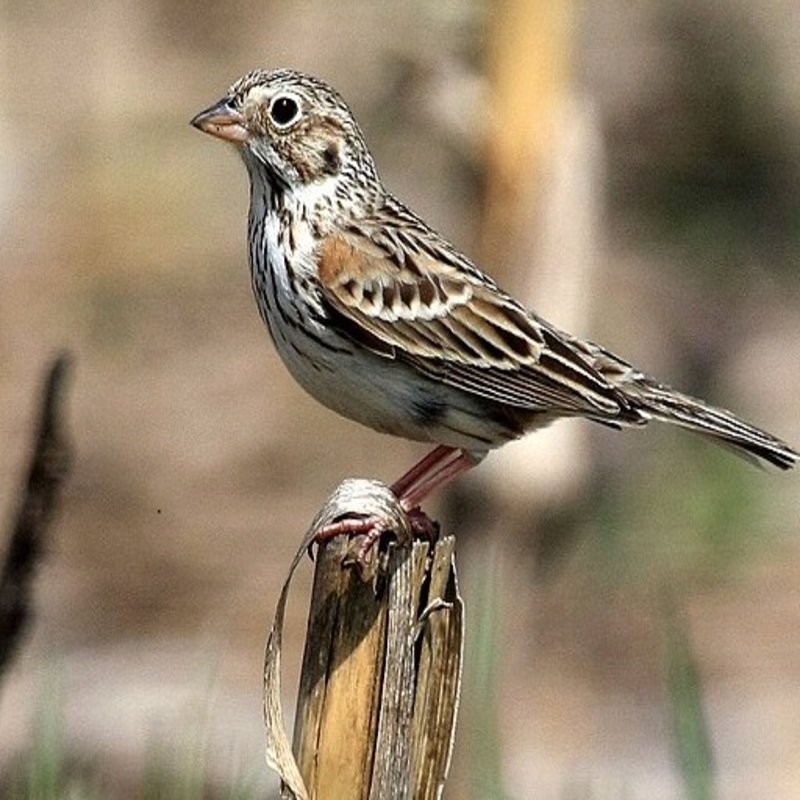Known as the vesper sparrow with Latin name Pooecetes gramineus is a medium-sized New World sparrow that can be found throughout the world. Pooecetes is a genus that contains only one species and belongs to the family of Passerellidae. The Vesper Sparrow is thought to be the most closely related sparrow to the Lark sparrow in terms of genetics.
Quick Overview: Pooecetes Gramineus – Vesper Sparrow Body size: Around 5.5-6.75 in (14-17 cm) and a weight of 28 g (1 oz).
Main colors: White, Black, Brown
Range: Throughout the United States
Migratory Bird: Yes
Best time of the year to see in the U.S.: January, February, June, July, August, September, December
Conservation Status: Least Concern
Vesper sparrow Description
White underparts, streaked breast and sides, and a medium-sized stocky sparrow with black upperparts. Black nose, white eye-ring, brown cheek patch White bars, and rufous shoulder patches adorn the wings. Notched dark tail with white edges sexes resemble.

Size
These birds have a length of 5.5-6.75 in (14-17 cm) and a weight of 28 g (1 oz). Their wings could range from 10-11.25 in (25-29cm).
Feeding
During the summer, it preys on insects, spiders, and other small invertebrates, among other things.
Habitat
They prefer dry areas with patchy shrub-like vegetation. Vesper sparrows announce territories from high perches. Their non-breeding habitat is dry shrubland and grassland. Vesper sparrows avoid dense foliage.
Behavior
Vesper sparrows sing to establish territories and select mates. Males and females communicate visually and audibly during mating and courtship. Males fly toward females or in front of her, wings and tails spread. Males will occasionally fly and sing during courtship. Male Passeriformes, including vesper sparrows, may feed females during courtship or otherwise.
Pooecetes gramineus Scientific Classification
- Kingdom: Animalia
- Phylum: Chordata
- Subphylum: Chelicerata
- Class: Aves
- Order: Passeriformes
- Family: Passerellidae
- Genus: Pooecetes
- Species: Pooecetes gramineu
Best time of the year to see
The best time to see these birds in the United States are during summer (June to September) and winter (December to February).
Distribution of the Vesper sparrow in the USA
Vesper sparrows inhabit the Nearctic. During the summer breeding season, their range extends into northern Pennsylvania, Ohio, Indiana, northern Missouri, and the Appalachian region of Virginia. They are found in northern Arizona, New Mexico, western Colorado, and northern Nebraska. Their breeding range extends north into Alberta and Saskatchewan.
The Vesper sparrow can also be found in the following states in the United States – Alabama, Alaska, Arkansas, California, Connecticut, Delaware, Florida, Georgia, Hawaii, Idaho, Illinois, Iowa, Kansas, Kentucky, Louisiana, Maine, Maryland, Massachusetts, Michigan, Minnesota, Mississippi, Montana, Nevada, New Hampshire, New Jersey, New York, North Carolina, North Dakota, Oklahoma, Oregon, Rhode Island, South Carolina, South Dakota, Tennessee, Texas, Utah, Vermont, Washington, West Virginia, Wisconsin, and Wyoming.
